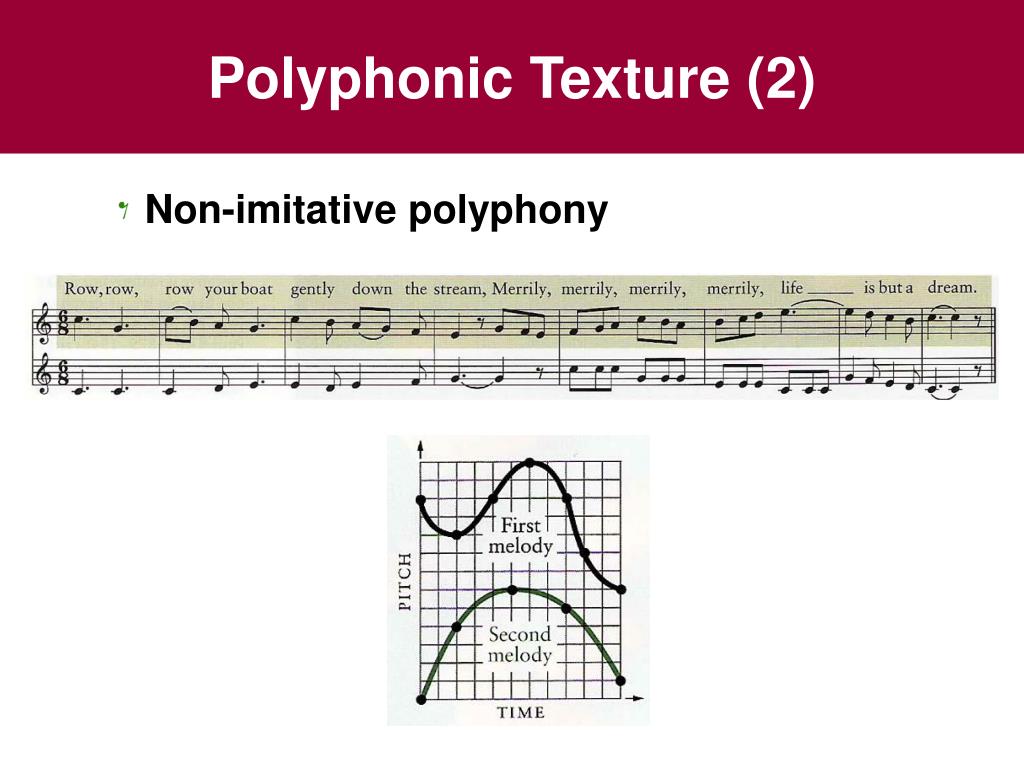

The “March of the Toreadors” from Bizet’s Carmen.The “graduation march” section of Edward Elgar’s “Pomp and Circumstance No.A classic Scott Joplin rag such as “Maple Leaf Rag” or “The Entertainer”.Two or more melodies at the same time with different variations on the melody.

You’d be surprised at how many of our favorite songs utilize polyphonic music, so even if you aren’t a fan of the classics, we have them to thank for almost all the music techniques implemented today.Heterophonic Texture. Polyphonic music has a rich history and remains prevalent today, but it isn’t as well-known or highlighted as it was in the past. Music today uses polyphonic techniques within songs to create an effect on the listener, but it started as a type of music to stand alone in the Rennaisance. Polyphonic music utilizes a mix of different melodies, rhythms, and voices to create an impeccable sound. It’s used as a technique within a song as opposed to consuming the entire length of a music piece. Popular polyphonic music is seen today mixed in with homophonic and monophonic songs. Perotin, a french composer, was the first to use polyphonic music.īach, alongside Giovanni Pierluigi da Palestrina, inspired thousands of artists with their polyphonic techniques, even modern music. Music was a massive part of the Renaissance, and polyphonic music was everywhere, in churches, court chapels, and masses.īach is the most notable composer in the past that utilized polyphonic music and is still listened to this day, but he wasn’t the one to invent it. The Renaissance focused intently on culture and artistry amongst the many political changes of that period. Polyphonic music became popular during the Renaissance, which took place in the 15th and 16th centuries, but the earliest piece of polyphonic music discovered came from the 10th century. They’ve even won the UNESCO Pacha Prize for keeping Georgian polyphonic music alive. Their polyphonic singing, costumes, and dances capture the eyes of anyone who witnesses them perform. Rustavi Ensemble is a Georgian folk music group that put on a show for its viewers. They are well-known around the world and have been critically acclaimed as one of the best small choirs. Their music range typically stays in the classical range, but they can expand depending on the project. Polyphony is a choir group that was founded in 1986. It’s a modernized version of polyphonic music that contrasts deeply with the original, classical tone most polyphonic songs derive from. They are a large number of songs and a smaller following, but their followers are loyal. Polyphonix is a music ensemble that creates high-energy, techno music in Tokyo, Japan. They aren’t as well known as others on the list, but they constantly try new polyphonic sounds. They are a group that pushes boundaries and loves finding new music that compliments one another. Polyphonic Exophilia is a music group, and recording studio, with an independent label. The Polyphonic Spree has 27 members, a ten-piece choir, and instruments ranging from classical to rock. Since they formed in 2000, they’ve worked with a few music labels and have had songs featured in the background for movies. They are one of the most popular polyphonic music groups. The Polyphonic Spree is a modern music group that only makes polyphonic music. The music itself has evolved, but its roots remain the same. The top five polyphonic musicians range from when they first started to now. They focus solely on creating music with diverse melodies and voices. While we’ve gone over popular modern songs that implement polyphonic techniques, these five polyphonic musicians are not as well-known.


 0 kommentar(er)
0 kommentar(er)
